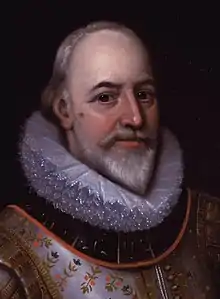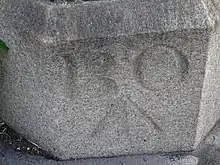Irish Board of Ordnance
The Board of Ordnance in the Kingdom of Ireland (1542–1800) performed the equivalent duties of the British Board of Ordnance: supplying arms and munitions, overseeing the Royal Irish Artillery and the Irish Engineers, and maintaining the fortifications in the island.


Following the Acts of Union 1800, the Board was abolished and the duties taken over by the United Kingdom Board of Ordnance. The various officials of the Board were compensated with pensions for their loss of salary and emoluments.
Officials of the Board of Ordnance
lists are incomplete before 1760
Master-General of the Ordnance
Salary in 1800: £1,500[1]
- In 1539: Sir John Travers
- 1559–1587: Edward Maria Wingfield
- 1588: Sir George Carew[2]
- 1592: Sir George Bourchier[3]
- 1605: Oliver St John, 1st Viscount Grandison[4]
- 1614: ...
- 1617: Toby Caulfeild, 1st Baron Caulfeild
- 1627: William Caulfeild, 2nd Baron Caulfeild
- 1634: Sir John Borlase[5] (jointly with Sir Thomas Lucas)
- 1648: Roger Boyle, 1st Baron Broghill[6]
- ...
- 1660: Hugh Montgomery, 1st Earl of Mount Alexander[7]
- 1663: Sir Robert Byron[8]
- 1674: Sir Thomas Chicheley (also Master-General of the Ordnance in England)[9]
- 1679: Francis Aungier, 1st Earl of Longford[10]
- 1684: William Stewart, 1st Viscount Mountjoy[11]
- 1692: William Wolseley[12]
- 1698: Hugh Montgomery, 2nd Earl of Mount Alexander[7]
- 1705: Richard Ingoldsby[13]
- 1712: Charles Butler, 1st Earl of Arran
- 1714: William Stewart, 2nd Viscount Mountjoy[14]
- 1727: François de La Rochefoucauld, marquis de Montandre
- 1739: Richard Molesworth, 3rd Viscount Molesworth[15]
- 1758: James FitzGerald, 1st Duke of Leinster
- 1766: Richard Boyle, 2nd Earl of Shannon[16]
- 1770: Charles Moore, 1st Marquess of Drogheda
- 1797: Henry Lawes Luttrell, 2nd Earl of Carhampton[17]
- 1800: Thomas Pakenham
Pakenham was granted compensation of £1,200 per annum after the Union.[18]
Lieutenant-General of the Ordnance
Salary in 1800: £600[19]
- 1660: Sir Albert Conyngham[20]
- 1687: John Giles[21]
- 1689: William Mansel Barker (Jacobite)[22]
- 1692: Francis Cuffe
- 1695: Chidley Coote[23][24]
- 1698: Jermyn Wyche[25]
- 1702: Chidley Coote
- 1706: Thomas Burgh[26]
- 1714: Richard Molesworth[15]
- bef 1738: Edward Hill[27]
- ...
- 1759: Bernard Hale
- 1789: Henry Lawes Luttrell, 2nd Earl of Carhampton[17]
- 1797: Thomas Pakenham
- 1800: Marcus Beresford[28]
Beresford was granted compensation of £600 per annum after the Union.[18]
Surveyor-General of the Ordnance
Salary in 1800: £450[19]
- in 1704: George Houghton[24]
- in 1738: Peter Virasell
- by 1760: Ralph Ward
- 1789: Thomas Pakenham[29]
- 1797: Sir George Shee, 1st Baronet[30]
- 1799: Robert Uniacke
Uniacke was granted compensation of £1,206 13s. per annum after the Union.[31]
Clerk of the Ordnance
Salary in 1800: £300[19]
- 1691–aft. 1705: Edward Payne[24]
- ...
- bef. 1722–aft. 1738: Hector Pain[27]
- by 1760: Joseph Keene
- 1788: Isaac Corry[32]
- 1789: Richard Magenis[29]
- 1800: Ponsonby Tottenham[33]
Tottenham was granted compensation of £487 2s. 6d. per annum after the Union.[34]
Principal Storekeeper
Salary in 1800: £200[19]
- 1691: Hugh Rowley
- in 1738: John Favier[27]
- 1748: Thomas Coote
- 1768: John Creighton[35]
- 1775: Thomas Coghlan
- 1788: Thomas Pakenham
- 1789: Thomas Loftus[29]
- 1792: Richard Archdall[36]
- 1797: Charles Handfield
- 1798: Henry Alexander
- 1799: John Hobson
Hobson was granted compensation of £616 13s. 9d. per annum after the Union.[31]
Clerk of the Deliveries
Salary in 1800: £200[37]
- by 1760: John Gustavus Handcock
- 1767: John Magill
- 1775: Robert Tighe
- 1789: Edward King
- 1789: Robert Wynne[29]
Wynne was granted compensation of £400 per annum after the Union.[34]
References
- Robert Beatson, A political index to the histories of Great Britain and Ireland, volume III (London, 1806)
- Beatson (1806) page 345
- Dictionary of National Biography
- Patrick Cracroft-Brennan, Bath, Earl of (E, 1536 – 1654) Archived 18 May 2012 at the Wayback Machine in Cracroft's Peerage. Retrieved 7 April 2012.
- Patrick Cracroft-Brennan, Grandison, Viscount (I, 1621) in Cracroft's Peerage. Retrieved 7 April 2012.
- Terry Clavin, "Borlase, Sir John (c.1576–1648)", Oxford Dictionary of National Biography, Oxford University Press, 2004; online edn, Oct 2006 retrieved 9 April 2012
- "House of Commons Journal Volume 5: 17 March 1648". Journal of the House of Commons: volume 5: 1646–1648. Institute of Historical Research. 1802. Retrieved 9 April 2012.
- Patrick Cracroft-Brennan, Mount Alexander, Earl of (I, 1661–1757) Archived 31 August 2010 at the Wayback Machine in Cracroft's Peerage. Retrieved 7 April 2012.
- M.S. Carte Calendar Volume 37 (August – October 1663), . Retrieved 9 April 2012.
- Francis Duncan, History of the Royal Regiment of Artillery, p. 160, . Retrieved 9 April 2012.
- M. W. Helms and Basil Duke Henning, AUNGIER, Francis, 3rd Baron Aungier of Longford (c.1632–1700), of East Clandon, Surr. in The History of Parliament: the House of Commons 1660–1690, 1983. Retrieved 7 April 2012.
- Piers Wauchope, "Stewart, William, first Viscount Mountjoy (c.1650–1692)", Oxford Dictionary of National Biography, Oxford University Press, 2004 retrieved 7 April 2012
- Charles Dalton, "Wolseley, William (c.1640–1697)", rev. Harman Murtagh, Oxford Dictionary of National Biography, Oxford University Press, 2004 retrieved 7 April 2012
- H. M. Chichester, "Ingoldsby, Richard (1664/5–1712)", rev. Kenneth Ferguson, Oxford Dictionary of National Biography, Oxford University Press, 2004 retrieved 7 April 2012
- John Lodge and Mervyn Archdall, The Peerage of Ireland, volume VI (Dublin 1789) page 256
- Patrick Cracroft-Brennan, Molesworth, Viscount (I, 1716) Archived 22 August 2010 at the Wayback Machine in Cracroft's Peerage. Retrieved 7 April 2012.
- Patrick Cracroft-Brennan, Shannon, Earl of (I, 1756) Archived 15 February 2011 at the Wayback Machine in Cracroft's Peerage. Retrieved 18 March 2012.
- David R. Fisher, LUTTRELL, Henry Lawes, 2nd Earl of Carhampton (1737–1821), of Luttrellstown, co. Dublin and Painshill, Surr. in The History of Parliament: The House of Commons 1790–1820, 1986. Online edition. Retrieved 18 March 2012.
- Journals of the House of Commons, volume 59, page 774
- Beatson (1806) page 346
- [Journal of the Royal Society of Antiquaries of Ireland,
- Calendar of Treasury Books, volume 8
- Calendar of the Stuart papers belonging to His Majesty the King, p. 42,
- John Lodge and Mervyn Archdall, The Peerage of Ireland, volume II (Dublin 1789), page 69
- Sir James Ware, The Antiquities and History of Ireland (Dublin, 1705) page 187
- Eveline Cruickshanks & Stuart Handley, The House of Commons, 1690–1715, p. 933
- Rolf Loeber, "Burgh, Thomas (1670–1730)", Oxford Dictionary of National Biography, Oxford University Press, 2004 retrieved 7 April 2012
- Guy Miege, The Present State of Great Britain and Ireland (1738), p. 101,
- "No. 15306". The London Gazette. 1 November 1800. p. 1228.
- "No. 13134". The London Gazette. 26 September 1789. p. 617.
- George Edward Cokayne, The Complete Baronetage, volume V (Exeter, 1906), page 433
- Journals of the House of Commons, volume 59, page 775
- Arthur Aspinall, CORRY, Isaac (1752–1813), of Derrymore House, co. Armagh. in The History of Parliament: The House of Commons 1790–1820, 1986. Online edition. Retrieved 18 March 2012.
- J. M. Collinge, TOTTENHAM, Ponsonby (1746–1818), of Merrion Square, Dublin. in The History of Parliament: The House of Commons 1790–1820, 1986. Online edition. Retrieved 18 March 2012.
- Journals of the House of Commons, volume 59, page 776
- Patrick Cracroft-Brennan, Erne, Earl (I, 1789) Archived 16 May 2012 at the Wayback Machine in Cracroft's Peerage. Retrieved 18 March 2012.
- "No. 13409". The London Gazette. 24 April 1792. p. 259.
- Beatson (1806) page 347
- "No. 11994". The London Gazette. 10 July 1779. p. 4.